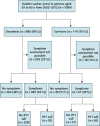Warning Symptoms Are Associated With Survival From Sudden Cardiac Arrest
- PMID: 26720493
- PMCID: PMC5624713
- DOI: 10.7326/M14-2342
Warning Symptoms Are Associated With Survival From Sudden Cardiac Arrest
Abstract
Background: Survival after sudden cardiac arrest (SCA) remains low, and tools for improved prediction of patients at long-term risk for SCA are lacking. Alternative short-term approaches aimed at preemptive risk stratification and prevention are needed.
Objective: To assess characteristics of symptoms in the 4 weeks before SCA and whether response to these symptoms is associated with better outcomes.
Design: Ongoing prospective population-based study.
Setting: Northwestern United States (2002 to 2012).
Patients: Residents aged 35 to 65 years with SCA.
Measurement: Assessment of symptoms in the 4 weeks preceding SCA and association with survival to hospital discharge.
Results: Of 839 patients with SCA and comprehensive assessment of symptoms (mean age, 52.6 years [SD, 8]; 75% men), 430 (51%) had warning symptoms (50% of men vs. 53% of women; P = 0.59), mainly chest pain and dyspnea. In most symptomatic patients (93%), symptoms recurred within the 24 hours preceding SCA. Only 81 patients (19%) called emergency medical services (911) to report symptoms before SCA; these persons were more likely to be patients with a history of heart disease (P < 0.001) or continuous chest pain (P < 0.001). Survival when 911 was called in response to symptoms was 32.1% (95% CI, 21.8% to 42.4%) compared with 6.0% (CI, 3.5% to 8.5%) in those who did not call (P < 0.001).
Limitation: Potential for recall and response bias, symptom assessment not available in 24% of patients, and missing data for some patients and SCA characteristics.
Conclusion: Warning symptoms frequently occur before SCA, but most are ignored. Emergent medical care was associated with survival in patients with symptoms, so new approaches are needed for short-term prevention of SCA.
Primary funding source: National Heart, Lung, and Blood Institute.
Conflict of interest statement
No Conflict of Interest
Figures


Comment in
-
Warning signs are common in the days before cardiac arrest but are often ignored.BMJ. 2015 Dec 22;351:h6882. doi: 10.1136/bmj.h6882. BMJ. 2015. PMID: 26696250 No abstract available.
Summary for patients in
-
Summaries for Patients. Warning Symptoms May Prevent Some Cases of Sudden Cardiac Arrest.Ann Intern Med. 2016 Jan 5;164(1). doi: 10.7326/P16-9001. Epub 2016 Dec 22. Ann Intern Med. 2016. PMID: 26720628 No abstract available.
Similar articles
-
Summaries for Patients. Warning Symptoms May Prevent Some Cases of Sudden Cardiac Arrest.Ann Intern Med. 2016 Jan 5;164(1). doi: 10.7326/P16-9001. Epub 2016 Dec 22. Ann Intern Med. 2016. PMID: 26720628 No abstract available.
-
Sudden cardiac arrest during sports activity in middle age.Circulation. 2015 Apr 21;131(16):1384-91. doi: 10.1161/CIRCULATIONAHA.114.011988. Epub 2015 Apr 6. Circulation. 2015. PMID: 25847988 Free PMC article.
-
Cardiac arrest witnessed by emergency medical services personnel: descriptive epidemiology, prodromal symptoms, and predictors of survival. OPALS study group.Ann Emerg Med. 2000 Feb;35(2):138-46. Ann Emerg Med. 2000. PMID: 10650231
-
Emergency department factors associated with survival after sudden cardiac arrest.Resuscitation. 2013 Mar;84(3):292-7. doi: 10.1016/j.resuscitation.2012.10.013. Epub 2012 Oct 24. Resuscitation. 2013. PMID: 23103887 Review.
-
Inter-association task force recommendations on emergency preparedness and management of sudden cardiac arrest in high school and college athletic programs: a consensus statement.Clin J Sport Med. 2007 Mar;17(2):87-103. doi: 10.1097/JSM.0b013e3180415466. Clin J Sport Med. 2007. PMID: 17414476
Cited by
-
Characteristics and clinical assessment of unexplained sudden cardiac arrest in the real-world setting: focus on idiopathic ventricular fibrillation.Eur Heart J. 2018 Jun 1;39(21):1981-1987. doi: 10.1093/eurheartj/ehy098. Eur Heart J. 2018. PMID: 29566157 Free PMC article.
-
COVID-19 and the global OHCA crisis: An urgent need for system level solutions.Resuscitation. 2020 Dec;157:274-276. doi: 10.1016/j.resuscitation.2020.11.004. Epub 2020 Nov 9. Resuscitation. 2020. PMID: 33181230 Free PMC article. No abstract available.
-
Warning symptoms associated with imminent sudden cardiac arrest: a population-based case-control study with external validation.Lancet Digit Health. 2023 Nov;5(11):e763-e773. doi: 10.1016/S2589-7500(23)00147-4. Epub 2023 Aug 26. Lancet Digit Health. 2023. PMID: 37640599 Free PMC article.
-
Sex-Based Disparities in Incidence, Treatment, and Outcomes of Cardiac Arrest in the United States, 2003-2012.J Am Heart Assoc. 2016 Jun 22;5(6):e003704. doi: 10.1161/JAHA.116.003704. J Am Heart Assoc. 2016. PMID: 27333880 Free PMC article.
-
Wolf Creek XVII part 3: Automated cardiac arrest diagnosis.Resusc Plus. 2023 Nov 20;16:100499. doi: 10.1016/j.resplu.2023.100499. eCollection 2023 Dec. Resusc Plus. 2023. PMID: 38059269 Free PMC article. Review.
References
-
- Go AS, Mozaffarian D, Roger VL, Benjamin EJ, Berry JD, Blaha MJ, Dai S, Ford ES, Fox CS, Franco S, Fullerton HJ, Gillespie C, Hailpern SM, Heit JA, Howard VJ, Huffman MD, Judd SE, Kissela BM, Kittner SJ, Lackland DT, Lichtman JH, Lisabeth LD, Mackey RH, Magid DJ, Marcus GM, Marelli A, Matchar DB, McGuire DK, Mohler ER, 3rd, Moy CS, Mussolino ME, Neumar RW, Nichol G, Pandey DK, Paynter NP, Reeves MJ, Sorlie PD, Stein J, Towfighi A, Turan TN, Virani SS, Wong ND, Woo D, Turner MB, American Heart Association Statistics Committee and Stroke Statistics Subcommittee Heart disease and stroke statistics–2014 update: a report from the American Heart Association. Circulation. 2014;129:e28–e292. - PMC - PubMed
-
- Sasson C, Rogers MA, Dahl J, Kellermann AL. Predictors of survival from out-of-hospital cardiac arrest: a systematic review and meta-analysis. Circ Cardiovasc Qual Outcomes. 2010;3(1):63–81. - PubMed
-
- Pauker SG, Estes NA, Salem DN. Preventing sudden cardiac death: can we afford the benefit? Ann Intern Med. 2005;142(8):664–6. - PubMed
-
- Achtelik M. Preventing sudden cardiac death. Ann Intern Med. 2005;143(10):756. author reply. - PubMed
Publication types
MeSH terms
Grants and funding
LinkOut - more resources
Full Text Sources
Other Literature Sources
Medical
Miscellaneous
